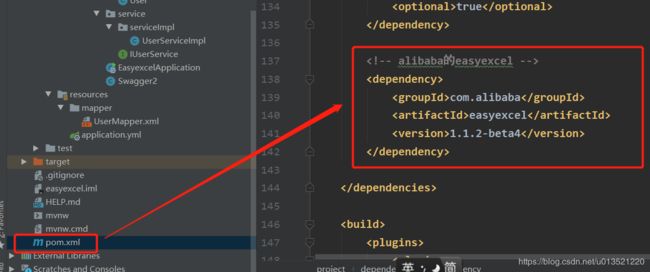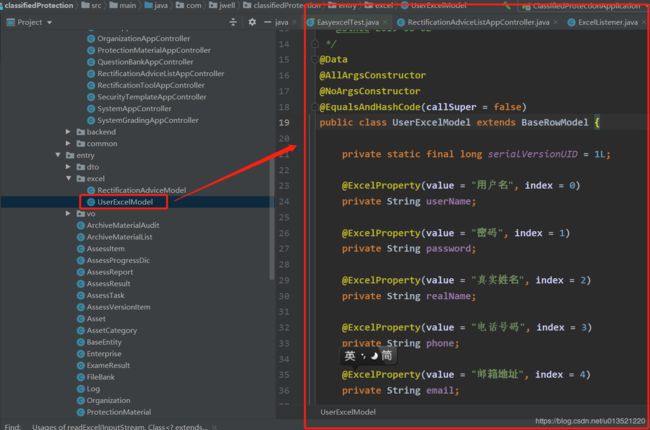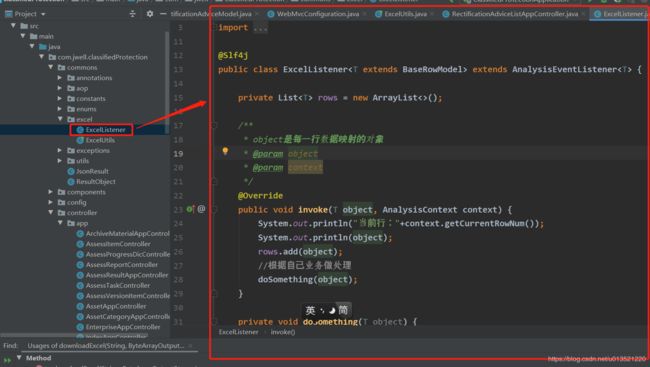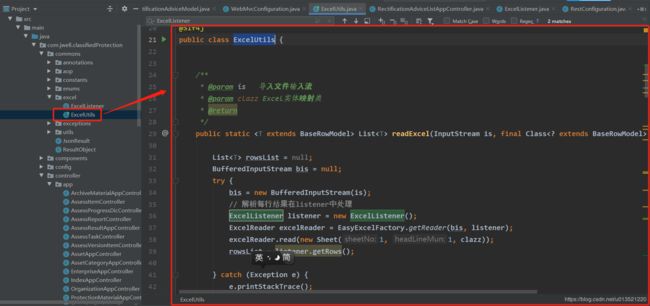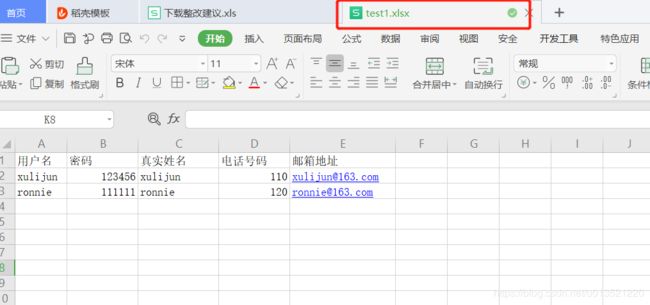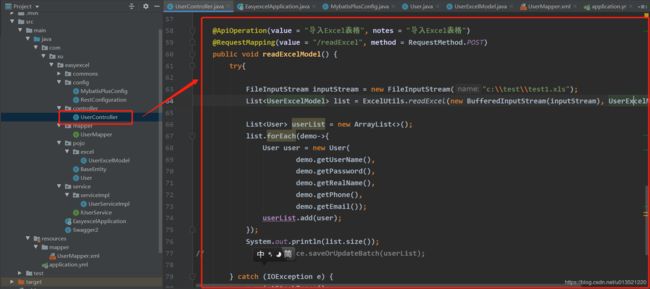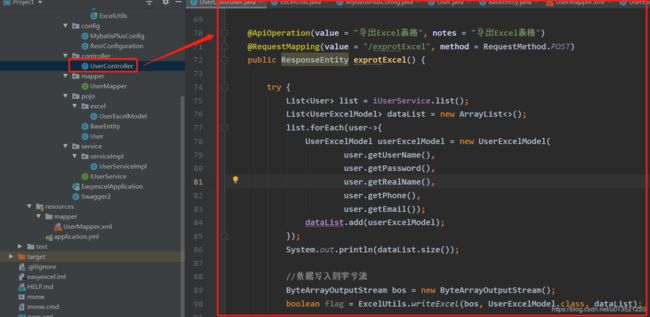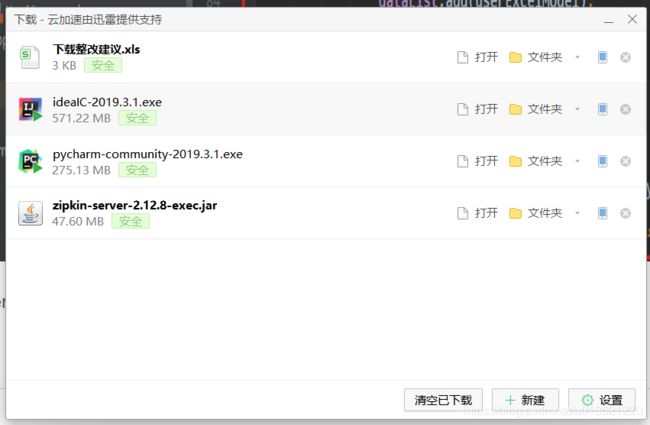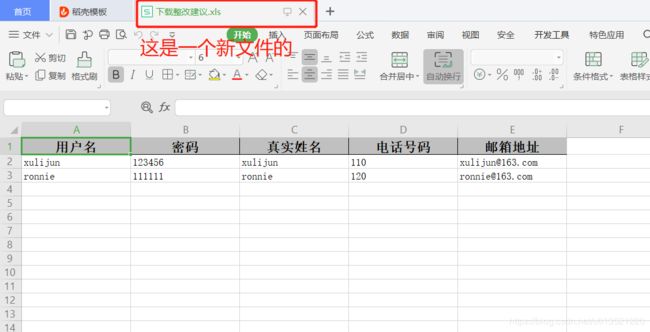SpringBoot学习之easyexcel导出和写入Excel(三)
easyexcel是阿里巴巴旗下开源项目,主要用于Excel文件的导入和导出处理,今天我们利用SpringBoot和easyexcel实战演示如何导出和写入Excel文件。一、加入我们需要的easyexcel依赖
我们项目还用了其他依赖,我把我的pom文件全部贴在下面,读者自行根据需要取舍
4.0.0
org.springframework.boot
spring-boot-starter-parent
2.2.3.RELEASE
com.xu
easyexcel
0.0.1-SNAPSHOT
easyexcel
Demo project for Spring Boot
UTF-8
UTF-8
1.8
2.9.2
2.9.2
org.springframework.boot
spring-boot-starter-web
org.springframework.boot
spring-boot-starter
org.springframework.boot
spring-boot-starter-test
test
junit
junit
4.12
test
com.baomidou
mybatis-plus-boot-starter
3.1.0
io.springfox
springfox-swagger-ui
${swagger-ui.version}
io.springfox
springfox-swagger2
${swagger2.version}
io.swagger
swagger-annotations
io.swagger
swagger-models
io.swagger
swagger-annotations
1.5.21
io.swagger
swagger-models
1.5.21
com.alibaba
druid
1.0.29
mysql
mysql-connector-java
5.1.38
org.projectlombok
lombok
1.16.16
com.alibaba
fastjson
1.2.46
org.springframework
springloaded
1.2.8.RELEASE
provided
org.springframework.boot
spring-boot-devtools
true
com.alibaba
easyexcel
1.1.2-beta4
org.springframework.boot
spring-boot-maven-plugin
二、定义我们的POJO
我们如果读Excel文件或者写入Excel,我们就需要先定义一个模型对应我们的Excel表格数据
package com.jwell.classifiedProtection.entry.excel;
import com.alibaba.excel.annotation.ExcelProperty;
import com.alibaba.excel.metadata.BaseRowModel;
import lombok.*;
/**
*
* 系统
*
*
* @author RonnieXu
* @since 2019-08-02
*/
@Data
@AllArgsConstructor
@NoArgsConstructor
@EqualsAndHashCode(callSuper = false)
public class UserExcelModel extends BaseRowModel {
private static final long serialVersionUID = 1L;
@ExcelProperty(value = "用户名", index = 0)
private String userName;
@ExcelProperty(value = "密码", index = 1)
private String password;
@ExcelProperty(value = "真实姓名", index = 2)
private String realName;
@ExcelProperty(value = "电话号码", index = 3)
private String phone;
@ExcelProperty(value = "邮箱地址", index = 4)
private String email;
private String roleType;
private Integer departmentId;
private String remark;
}
三、定义我们的监听器和导入导出方法
我们定义了一个导出导入工具类,这个类需要一个导入导出的监听器,监听器如下
package com.jwell.classifiedProtection.commons.excel;
import com.alibaba.excel.context.AnalysisContext;
import com.alibaba.excel.event.AnalysisEventListener;
import com.alibaba.excel.metadata.BaseRowModel;
import lombok.Data;
import lombok.extern.slf4j.Slf4j;
import java.util.ArrayList;
import java.util.List;
@Slf4j
public class ExcelListener extends AnalysisEventListener {
private List rows = new ArrayList<>();
/**
* object是每一行数据映射的对象
* @param object
* @param context
*/
@Override
public void invoke(T object, AnalysisContext context) {
System.out.println("当前行:"+context.getCurrentRowNum());
System.out.println(object);
rows.add(object);
//根据自己业务做处理
doSomething(object);
}
private void doSomething(T object) {
//1、入库调用接口
}
@Override
public void doAfterAllAnalysed(AnalysisContext context) {
log.info("read {} rows %n", rows.size());
}
public List getRows() {
return rows;
}
public void setRows(List rows) {
this.rows = rows;
}
}
导入导出类ExcelUtils中有三个方法,导入方法、导出方法和下载方法导出文件方法【这个方法不需要的可以不用理会】
package com.jwell.classifiedProtection.commons.excel;
import com.alibaba.excel.EasyExcelFactory;
import com.alibaba.excel.ExcelReader;
import com.alibaba.excel.ExcelWriter;
import com.alibaba.excel.metadata.BaseRowModel;
import com.alibaba.excel.metadata.Sheet;
import com.alibaba.excel.support.ExcelTypeEnum;
import com.jwell.classifiedProtection.entry.excel.UserExcelModel;
import lombok.extern.slf4j.Slf4j;
import org.springframework.http.HttpHeaders;
import org.springframework.http.HttpStatus;
import org.springframework.http.MediaType;
import org.springframework.http.ResponseEntity;
import java.io.*;
import java.util.ArrayList;
import java.util.List;
@Slf4j
public class ExcelUtils {
/**
* @param is 导入文件输入流
* @param clazz Excel实体映射类
* @return
*/
public static List readExcel(InputStream is, final Class clazz){
List rowsList = null;
BufferedInputStream bis = null;
try {
bis = new BufferedInputStream(is);
// 解析每行结果在listener中处理
ExcelListener listener = new ExcelListener();
ExcelReader excelReader = EasyExcelFactory.getReader(bis, listener);
excelReader.read(new Sheet(1, 1, clazz));
rowsList = listener.getRows();
} catch (Exception e) {
e.printStackTrace();
return null;
} finally {
if (bis != null) {
try {
bis.close();
} catch (IOException e) {
e.printStackTrace();
}
}
}
return rowsList;
}
/**
*
* @param os 文件输出流
* @param clazz Excel实体映射类
* @param data 导出数据
* @return
*/
public static Boolean writeExcel(OutputStream os, Class clazz, List data){
BufferedOutputStream bos= null;
try {
bos = new BufferedOutputStream(os);
ExcelWriter writer = new ExcelWriter(bos, ExcelTypeEnum.XLSX);
//写第一个sheet, sheet1 数据全是List 无模型映射关系
Sheet sheet1 = new Sheet(1, 0,clazz);
writer.write(data, sheet1);
writer.finish();
} catch (Exception e) {
e.printStackTrace();
return false;
} finally {
if (bos != null) {
try {
bos.close();
} catch (IOException e) {
e.printStackTrace();
}
}
}
return true;
}
/**
* ResponseEntity下载文件
*
* @param fileName
* @param byteOutPutStream
*/
public static ResponseEntity downloadExcel(String fileName, ByteArrayOutputStream byteOutPutStream) {
//下载文件
try {
HttpHeaders headers = new HttpHeaders();
headers.setContentType(MediaType.APPLICATION_OCTET_STREAM);
headers.setContentDispositionFormData("attachment",
new String(fileName.getBytes("GBK"), "ISO8859-1"));// 文件名称
ResponseEntity responseEntity = new ResponseEntity(byteOutPutStream.toByteArray(), headers, HttpStatus.CREATED);
return responseEntity;
} catch (Exception e) {
e.printStackTrace();
}
return null;
}
/**
* 这是你最熟悉的老朋友Main方法,哈哈哈
* @param args
*/
public static void main(String[] args) {
//1.导入Excel
FileInputStream fis = null;
try {
fis = new FileInputStream("c:\\test\\test1.xls");
List userExcelModelList = ExcelUtils.readExcel(fis, UserExcelModel.class);
System.out.println("导入是否成功:-------------->"+"数据行数是:"+userExcelModelList.size());
} catch (FileNotFoundException e) {
e.printStackTrace();
}finally {
if (fis != null){
try {
fis.close();
} catch (IOException e) {
e.printStackTrace();
}
}
}
//2.导出Excel
FileOutputStream fos = null;
try {
fos = new FileOutputStream("D:\\export.xlsx");
//FileOutputStream fos, Class clazz, List data
List list = new ArrayList<>();
for (int i = 0; i < 5; i++) {
UserExcelModel excelEntity = new UserExcelModel();
excelEntity.setUserName("我是名字" + i);
list.add(excelEntity);
}
Boolean flag = ExcelUtils.writeExcel(fos, UserExcelModel.class, list);
System.out.println("导出是否成功:" + flag);
} catch (FileNotFoundException e) {
e.printStackTrace();
} finally {
if (fos != null) {
try {
fos.close();
} catch (IOException e) {
e.printStackTrace();
}
}
}
}
}
四、测试导入和导出【下载导出的Excel文件】
1、导入测试
新建一个Excel文件,我的文件路径是c:\\test\\test1.xlsx
我的controller方法如下
package com.xu.easyexcel.controller;
import com.xu.easyexcel.commons.excel.ExcelUtils;
import com.xu.easyexcel.pojo.User;
import com.xu.easyexcel.pojo.excel.UserExcelModel;
import com.xu.easyexcel.service.IUserService;
import io.swagger.annotations.Api;
import io.swagger.annotations.ApiOperation;
import lombok.extern.slf4j.Slf4j;
import org.springframework.beans.factory.annotation.Autowired;
import org.springframework.http.ResponseEntity;
import org.springframework.transaction.annotation.Transactional;
import org.springframework.web.bind.annotation.RequestMapping;
import org.springframework.web.bind.annotation.RequestMethod;
import org.springframework.web.bind.annotation.RestController;
import java.io.BufferedInputStream;
import java.io.ByteArrayOutputStream;
import java.io.FileInputStream;
import java.io.IOException;
import java.util.ArrayList;
import java.util.List;
/**
*
* 整改建议详情列表详情列表 前端控制器
*
*
* @author RonnieXu
* @since 2019-08-29
*/
@Slf4j
@Transactional(rollbackFor = Exception.class)
@Api(value = "用户接口", tags = "用户接口")
@RestController
@RequestMapping("/user")
public class UserController {
@Autowired
private IUserService iUserService;
@ApiOperation(value = "导入Excel表格", notes = "导入Excel表格")
@RequestMapping(value = "/readExcel", method = RequestMethod.POST)
public void readExcelModel() {
try{
FileInputStream inputStream = new FileInputStream("c:\\test\\test1.xlsx");
List list = ExcelUtils.readExcel(new BufferedInputStream(inputStream), UserExcelModel.class);
List userList = new ArrayList<>();
list.forEach(demo->{
User user = new User(
demo.getUserName(),
demo.getPassword(),
demo.getRealName(),
demo.getPhone(),
demo.getEmail());
userList.add(user);
});
System.out.println(list.size());
//将表格数据保存到数据库
iUserService.saveOrUpdateBatch(userList);
} catch (IOException e) {
e.printStackTrace();
}
}
@ApiOperation(value = "导出Excel表格", notes = "导出Excel表格")
@RequestMapping(value = "/exprotExcel", method = RequestMethod.POST)
public ResponseEntity exprotExcel() {
try {
List list = iUserService.list();
List dataList = new ArrayList<>();
list.forEach(user->{
UserExcelModel userExcelModel = new UserExcelModel(
user.getUserName(),
user.getPassword(),
user.getRealName(),
user.getPhone(),
user.getEmail());
dataList.add(userExcelModel);
});
System.out.println(dataList.size());
//数据写入到字节流
ByteArrayOutputStream bos = new ByteArrayOutputStream();
boolean flag = ExcelUtils.writeExcel(bos, UserExcelModel.class, dataList);
//下载文件
String fileName = "下载整改建议.xls";
log.info("开始下载导出的Excel文件");
return ExcelUtils.downloadExcel(fileName, bos);
} catch (Exception e) {
e.printStackTrace();
}
return null;
}
}
打开swagger,点击测试,可以看到成功读取到了Excel文件的数据,并成功插入到数据库
2、导出测试【下载导出文件】
点击swagger方法测试或者直接在浏览器中输入http://localhost/user/exprotExcel,可以看到成下载了导出文件
【说明:在swagger中下载的文件名是乱码,暂时不知道哪里出了问题,后续知道原因再补充说明】
打开可以看到的确成功从把数据库数据导出并成功下载了
谢谢读者支持,下次再见!
